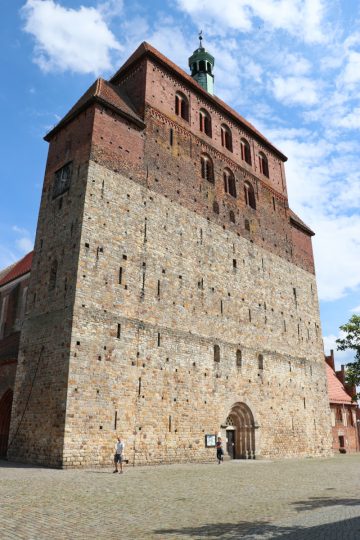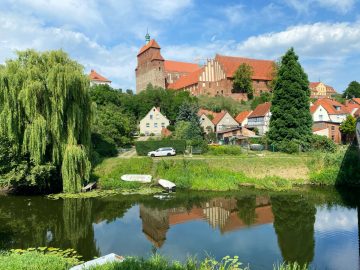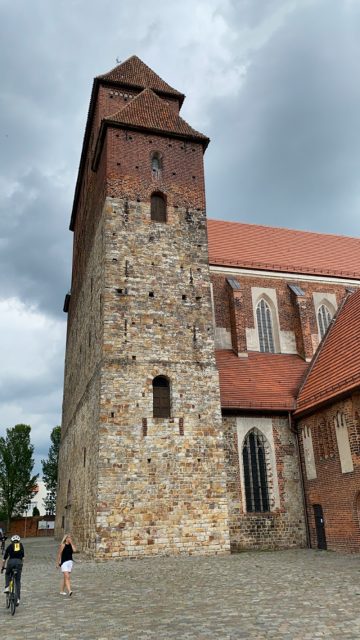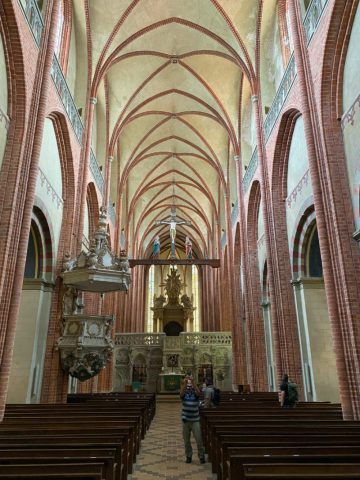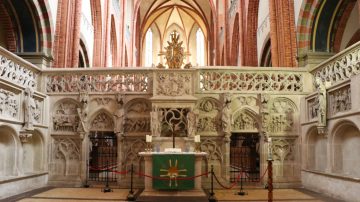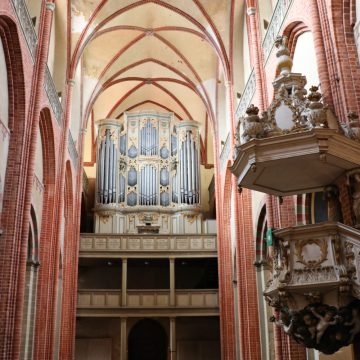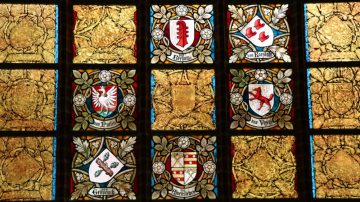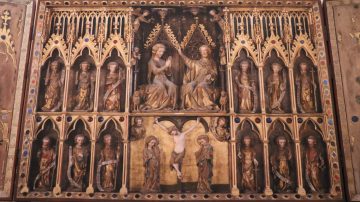The Romanesque-Gothic Dom in Havelberg with its mighty westwork is a popular stop on the Elbe Cycling Route and the Straße der Romanik in Saxony-Anhalt in Germany.
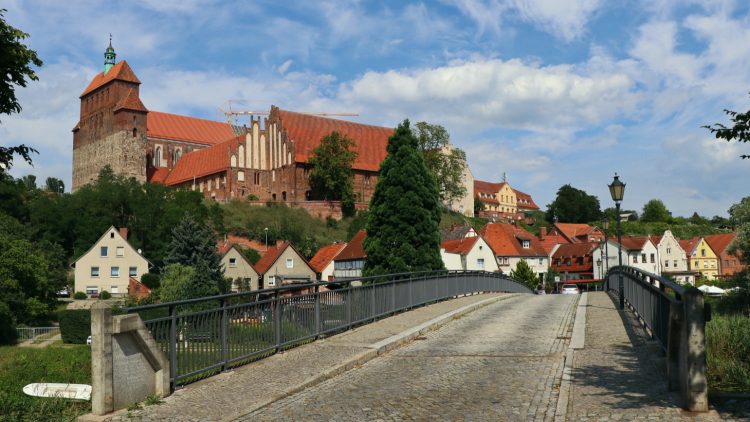
The Havelberger Dom (St Marien) is a large Romanesque-Gothic cathedral church with an impressive fort-like westwork, a triple-nave basilica, and a large monastery-like complex. The origins of the bishopric goes back a millennium to the time of German expansion to the east of the Elbe, while the church building recently celebrated its 850th anniversary. Havelberg on the border of Saxony-Anhalt and Brandenburg is a pleasant day-trip or weekend destination from Berlin and other larger cities in Germany such as Magdeburg, Wolfsburg, and Hannover. The region is also popular for cycling, hiking, and boating holidays.
Havelberg in Prignitz and Brandenburg
Driving to Havelberg on minor backroads from the Autobahn exit takes visitors through rural modern-day Brandenburg and Saxony-Anhalt. Even allowing that roadworks may require the use of minor, even cobblestone roads, the drive feels at times as if traveling to the back of beyond. A pleasant reminder that provincial Germany is at times astonishingly beautiful.
Modern suburbs spoil the surprise somewhat but once facing the monumental Romanesque westwork of the Dom St. Marien and the panoramic view of the old town on an island, it is obvious that at some point in history, Havelberg was an important town.
Havelberg entered written history during the 10th century when the East Francians started to cross the Elbe to conquer and Christianize the Slavic people. By the mid-century Emperor Otto I (the Great) founded the bishoprics of Havelberg and the eventually much more famous Brandenburg. The town was thus for a period at the edge of the “civilized” world.
However, the Slavs fought back and Havelberg was only brought back into the empire after the Wendish Crusade (1147). After a century and a half, the bishop of Havelberg could start the construction of the cathedral as bishop seat and no longer reign just from a distance.
Despite Havelberg strategic location near the confluence of the Havel River (which also flows through Potsdam and Berlin) and the Elbe (links to Hamburg amongst others), the territory was hard to defend. Political and economic favor went to other nearby towns, the bishop decided to reside elsewhere, and Havelberg seemingly never really developed its full potential.
Despite Havelberg’s long association with Brandenburg and the Prignitz region, it became part of the Magdeburg district in 1952 and thus part of Saxony-Anhalt after the reunification of Germany in 1990. An attempt to return to Brandenburg was narrowly defeated in the town council at the time of reunification. The town currently has around 7,000 inhabitants.
Havelberger Dom Sankt Marien
Although the bishopric of Havelberg was founded probably in 948 — a falsified document of 1179 claimed 946 in an attempt to make it older than Brandenburg — it took two centuries before the bishop could establish his cathedral chapter here.
Construction of a Romanesque cathedral with a Premonstratensian collegiate chapter (Chorherrenstift) started in 1150 and the church was already consecrated in 1170 as the Dom Sankt Marien (Cathedral of St Mary) — a name that survived through the protestant era to the present.
The mighty Romanesque westwork and the lower parts of the church survived from this early period. Following a fire, the upper parts of the church were rebuilt between 1279 and 1330 in the by then fashionable Gothic style. For political reasons, the bishop by then had already moved his main residence in Wittstock but the cathedral chapter remained in Havelberg,.
The region accepted the Lutheran reformation relatively late with the Romantic Catholic monastery only disbanded in 1561 and the Domstift (cathedral chapter) surviving as a protestant institution until 1819. The church was restored and “improved” In the historicist Romantic spirit of the 19th century but much of the medieval building is original.
Like nearby Jerichow, Magdeburg, and Brandenburg, the church in Havelberg with attached cloisters and dormitory was never a monastery with monks living in isolation but rather a Premonstratensian collegiate chapter with canons.
Architecture of the Havelberger Dom
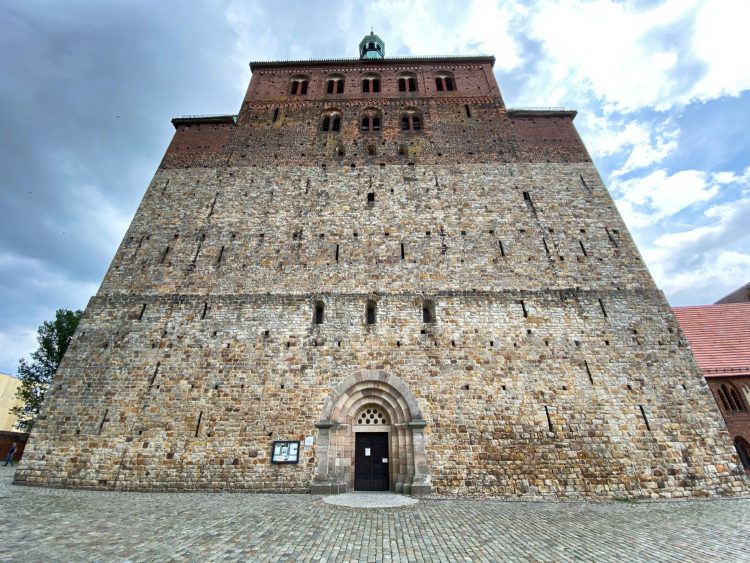
Although Havelberg Cathedral has a number of noteworthy artworks, the overwhelming architecture of the triple-nave basilica is the main reason to visit. The large church is impressive both from the outside and inside.
Romanesque Westwork of Havelberg Cathedral
The emblematic mighty westwork of the Havelberger Dom is generally what visitors see first. This massive windowless block built of stone measures 30 by 6 m and sours 31 m high. The stone facade remained largely unadorned.
The westwork was long considered as some kind of fort but more recent research showed evidence of three original ground level portals through the westwork into the church, which would hardly have made it a suitable defense structure. The slits really were to let light in rather than to shoot arrows out, and the high-level outer door was to hoist supplies through rather than to pull a ladder up. Even so, this does no exclude the possibility that the structure was at some time intended to be available for protection at short notice against unexpected attacks.
Already in 1200, a brick story was added to the tower to house the bells. A variety of different bricks were used making it still easy to distinguish this older section from the later additions.
During a restoration project in 1840/41 the Prussians added a neo-Gothic portal, which was converted to a Neo-Romanesque portal during further restoration projects in 1907-09. At this time a further brick story was added with arcades for the bells. This enhanced the proportions as the tower was considered too low for a church of such dimensions. This increased the total height of the tower with steeple to 47.5 m.
Romanesque-Gothic Church and Monastery
Despite the Neo-Romanesque western portal and the neo-Gothic northern portal, the church itself is usually entered via the paradise room and the cloisters of the complex. The lower walls and round arches of the basilica are the Romanesque originals but the church was repaired, walls increased in height, and topped off with Gothic cross vaulting between 1279 and 1330. The Romanesque half-round eastern apse was replaced by a Gothic choir using five sides of an octagon.
The current Dom St Marien measures 72.5 long, the central nave is up to 22 m high and 22.5 m wide. Despite the westwork and a similar if less robust structure on the eastern side (Querriegel) both protruding well beyond the width of the nave, the church has no transepts.
The east wing of the complex was built around 1200 making it amongst the oldest brick Romanesque structures in northern Germany. Much of the rest of the complex is from the 13th century although the vaulted roof was only added during the 14th century. Further expansion and alterations largely ended at the time of the Reformation.
Medieval Art Inside the Dom in Havelberg
The most attractive aspects of the interior of the Havelberger Dom are probably the stark clean lines of the Gothic vaulting and the Romanesque arches. The church is an excellent example of the symbiosis of these two medieval building styles.
Prior to the Reformation, the bishopric was relatively wealthy but only a few decorative items survived to the present and several are no longer complete either. However, many of these are of very good artistic quality.
The oldest decorative elements date from around the time of the completion of the Gothic reconstruction. These early 14th-century works include the grisaille painted windows, the triumphal crucifix of painted oak including a 2.6 m tall Christ (ca. 1280), three large sandstone candelabras, and some of the oak choir stalls. (The brick gothic Münster in Bad Doberan has a far more elaborately decorated double-sided 14th-century cross altar that is fully restored.)
Two of the large sandstone candelabras in the choir have two persons each: a novice and altar server (Messdiener), and a lay brother as cook (with a large spoon) and a brother with knife.
The early 15th-century sandstone rood screen (Lettner) is from the Parler School of Prague and uses 20 reliefs and 14 individual states to depict the passion of Christ.
Various graves, epitaphs, reliefs, and further sculptures are scattered throughout the church. The prominent tomb in the choir is of Bishop Johann Wöpelitz (1385-1401).
Post Reformation Artworks in the Basilica
The post-Reformation artworks include the Renaissance sandstone baptismal font (1588), the Baroque pulpit (1693), and the huge high altar with a large painting of the Last Supper dates from 1700.
The western end of the nave is dominated by the large Gottlieb Scholtze organ from 1777 — it has the sound to match its impressive looks. The organ has 34 stops (Register) played via two manuals and a set of pedals.
It is frequently played in concerts — often Saturday afternoons during the summer months — or listen to three Bach samples.
Stained-Glass Windows in the Havelberger Dom
Some of the stained-glass windows in the Havelberger Dom are from around 1300 and the 15th century while others where extensively restored or newly created around 1900.
The grisaille painted windows were made around 1300 by masters from Halberstadt and Stendal — two further Saxony-Anhalt towns with remarkable churches and extraordinary stained-glass windows.
The stained-glass windows with scenes from the life of Christ are from the early 15th century but some were extensively restored in 1895. The windows with family coats of arms in a historicist style were only made around 1897.
Some of the ceiling paintings, especially in the southern nave and Marienkapelle, are the originals from the early 14th century.
Havelberger Marienaltar or Rossower Altar
In preparation for the 850th anniversary of the Dom in 2020 — postponed until June 2021 — a large full-sized photo showed the winged altar that stood in the choir from 1411. As could be expected from in a St Marienkirche, this is a Marienaltar (Altar of the Virgin Mary) with the coronation of Mary at the center. Many protestants object to a depiction of this non-biblical event and the veneration of Mary. Although the name of the church survived, the altar was removed and since around 1607 stored in a small village church in Rossow near Wittstock.
The Havelberger Marienaltar — now known as the Rossower Altar — was damaged through the centuries, at least in part due to its large size requiring the removal of the wings to fit in the smaller church and only later rediscovered in bad condition in the bell tower. However, the central scenes survived in fairly good condition, although the crown of Mary has disappeared.
A remarkable feature of this retable is the inclusion of Judas Iscariot in the traditional rows of the disciples (bottom row first on the right). To preserve the symmetry, Judas is usually replaced in such lineups by Mathias (or Paul or John the Baptist or another saint) and only shown in scenes such as the Last Supper and the betrayal in Gethsemane.
Havelberg Monastery and Prignitz Museum
Visitors may freely explore the cloisters and a few rooms on the lower level of the former monastery-like complex. Also, on the outside is a small aromatic monastery garden with panoramic views of the old town and the surrounding countryside.
The Prignitz Museum of regional history opened in the upper levels of the building in 1904. Havelberg traditionally belonged to the rural Prignitz region, but the official political borders of this region now run just to the north of the town. It has an eclectic collection divided into three main sections: the conquering of the region by the Germans around a millennium ago, the history of the Dom, and the local history.
The small museum is interesting to see but certainly not the highest priority for most visitors.
Havelberg and the Amber Room
Havelberg’s moment in International diplomatic history came in 1716 when Czar Peter the Great and Prussian King Friedrich Wilhelm met in the town. Few remember what the meeting was about but the gifts the allies exchanged are known to even those with only a cursory knowledge of German history: the “Soldier King” received some “Langen Kerls” (“Potsdam Giants” — soldiers at least 188 cm tall) while the Czar received the Bernsteinzimmer (Amber Room) that famously disappeared without a trace during the Second World War.
Two sculptures near the Dom parking lot remind of the meeting, while a true copy of the Amber Room was reconstructed in the Cathrine Palace in St Petersburg in 2003.
Visitors Information for the Havelberger Dom
Opening hours of the Havelberg Dom are:
November to March:
- Wednesday to Saturday from 10:00 to 16;00
- Sunday and Holidays from noon to 16:00
April to October:
- Monday to Saturday from 10:00 to 18:00
- Sunday and holidays from noon to 18:00
Opening hours may be restricted due to services and concerts.
Admission is free to the church and cloisters. Admission to the Prignitz Museum is €4.
The Scholtzer organ is frequently played in concerts — admission usually around €10.
A great visual guide is Raymond Faure’s website with 380 photos of the Havelberger Dom (and many more of other sights on the Romanesque Road).
Visiting Havelberg in Saxony-Anhalt
Havelberg is a pleasant small town. The old town center is picturesquely located on an island in the Havel River while the Dom towers over the region from a promontory just to the north. A bridge over the canal and staircases link the center and the cathedral, alternatively it is a long drive. The town center is worth a stroll through although a major town fire in 1870 destroyed much of the historical substance.
Spending a sunny weekend afternoon in Havelberg makes it quickly clear that it is not totally off the beaten track. Driving there may be slow, especially when roadworks force detours along minor, often beautifully tree-lined country lanes, but it is a popular stop on major tourist routes through Germany, including the Elbe Radweg cycling route (and any others traveling along the Elbe or the Havel River) and the popular Straße der Romanik (Romanesque Road) which cuts a large figure eight to connect many Romanesque sights of Sachsen-Anhalt. Due to the traditional links with Brandenburg, it is also included in the western route of the Brandenburg-Berlin Romanesque Route.
The region is popular for short trips from Berlin and other larger centers with many holiday homes and a few hotels available — see Tripadvisor. Deals may often be had in quieter periods.
Transportation to Havelberg
Getting to the Havelberger Dom is easiest by car but public transportation is also possible. Havelberg is also popular with cyclists, canoeists, and hikers. A small parking lot is next to the Dom with further parking available downhill in the town center.
To reach Havelberg by public transportation, the most common routing is by train to Stendal and then by Stendal Bus 900 to Havelberg (80 minutes). The bus runs mostly hourly but there are some gaps in the timetable, especially on weekends. An alternative from the north and east (including Berlin) is the train to Glöwen and then bus 900 (10 minutes) to Havelberg — usually possible every two hours. Havelberg, Wasserturm is closest to the Dom but Havelberg, Uferstraße in the center is probably easier to use — buses stop at both. The Saxony-Anhalt-Ticket (or Saxony or Thuringia Ticket — they all cost the same and cover all three states) is valid on bus 900 if traveling via Stendal. For the routing via Glöwen, the Brandenburg-Berlin ticket may be used until Glöwen but not on bus 900 — see Ländertickets on how to save on local public transportation in Germany.
Other interesting sights nearby include the monastery of Jerichow, Tangermünde with its town walls and half-timbered buildings, and Stendal with fine churches and spectacular stained-glass windows.
